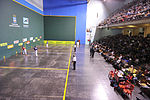Intxaurrondo station (Euskotren)
2012 establishments in the Basque Country (autonomous community)Euskotren Trena stationsRailway stations in San SebastiánRailway stations in Spain opened in 2012Spain rail transport stubs ... and 1 more
Wikipedia page with obscure subdivision

Intxaurrondo is a railway station in San Sebastián, Basque Country, Spain. It is owned by Euskal Trenbide Sarea and operated by Euskotren. It lies on the San Sebastián-Hendaye railway, popularly known as the Topo line. The Cercanías San Sebastián station of the same name serves the same area, but is unrelated to the Euskotren station.
Excerpt from the Wikipedia article Intxaurrondo station (Euskotren) (License: CC BY-SA 3.0, Authors, Images).Intxaurrondo station (Euskotren)
San Sebastián Hego Intxaurrondo (Intxaurrondo)
Geographical coordinates (GPS) Address Nearby Places Show on map
Geographical coordinates (GPS)
| Latitude | Longitude |
|---|---|
| N 43.31365 ° | E -1.95645 ° |
Address
20015 San Sebastián, Hego Intxaurrondo (Intxaurrondo)
Autonomous Community of the Basque Country, Spain
Open on Google Maps









